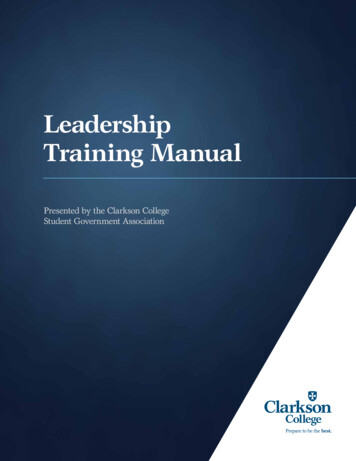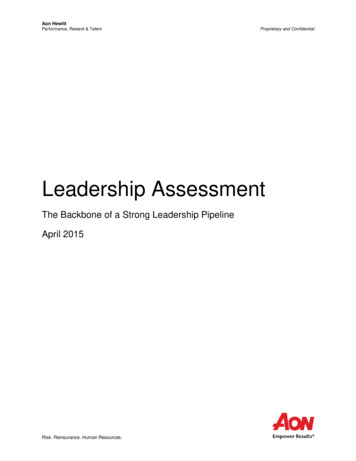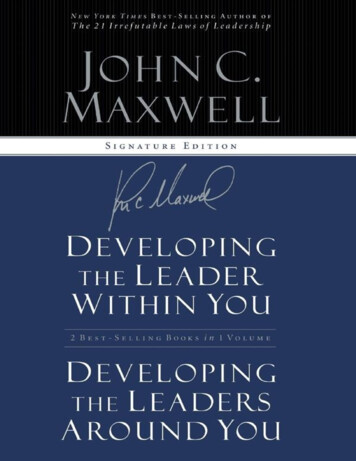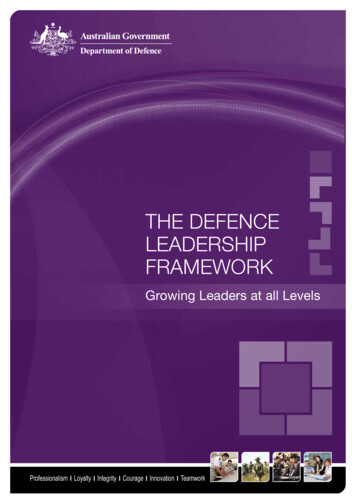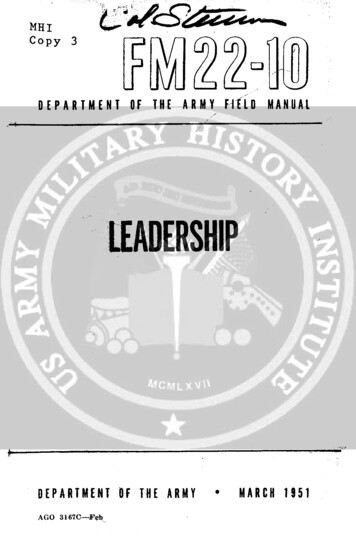
Transcription
MHICopy 3BDEPARTMENT OF THE ARMY FiELDMANUALLEADERSHIPDEPARTMENT OF THE ARMYAGO3167C-Feb*MARCH 1951
DEPARTMENT OF THE ARMYFM 22-10FIELD MANUALThis manual supersedes TC 6, 19 July 1948 and Department of theArmy Pamphlet 22-1, 28 December 1948LEADERSHIPDEPARTMENT OF THE ARMY·United States Government Printing OfficeWashington: 1951AGO 3167CMARCH 1951
DEPARTMENT OF THE ARMYWASHINGTON 25, D. C., 6 March' 1951FM 22-10 is published for the information and guidarof all concerned.[AG 353 (17 Jan 51)]BY ORDER OF THE SECRETARY OF THE ARMY:OFFICIAL:V'DWARD F. WITSELLMajor General, USAThe Adjutant GeneralJ. LAWTON COLLINSChief of StaffUnited States ArmyDISTRIBUTION:GSUSA (5); SSUSA (5); Adm Svc (2); Tech Svc(2); Arm & Svc Bd (2); AFF (40); AA Comd(5); OS Maj(5); A (20);Bn (5); C (5)FC (2); SchComd (5); Base Comd (5); MDWCHQ (5); D (5); B (5); R (5)except 5, 19 (10), 6, 7, 17, 44 (15);(25); PMS&T (2).-- explanation of distribution formula, see SR 310-AGO 3167C
FOREWORDPURPOSE OF THE STUDY OF LEADERSHIPToday, more than ever in history, the Army is inneed of leadership of the highest caliber. With theincrease in the complexity of warfare, the scienceof war is increasingly dependent upon humanguidance. No matter how complicated it may become, war is always waged by men. The man wholeads and the men who are led win wars. Everymember of our military force must be a leader,actually or potentially.The purpose of this manual is to provide military leaders, actual and prospective, with a practical guide for applying the principles of leadership. In the ultimate sense, leadership is notinherent; it depends upon traits which can bedeveloped, and upon the application of techniqueswhich can be learned. It is an art which can beacquired, cultivated, and practiced by anyone whopossesses the mental and physical ability and themoral and ethical integrity expected of a commissioned or noncommissioned officer. Developingthe art is a continuing process which involves therecognition and practice of the basic traits ofleadership and the understanding and applicationof sound leadership principles and techniques.This manual stresses the importance of selfimprovement. The principles, character traits,and procedures set forth are offered as an assistance to the leader in the problem of controllingothers. By applying these procedures to his ownpractice and by analyzing his own traits of charAGO 3167Cm
acter, the leader will possess a yardstick for measuring his own success or failure.Despite this guide, it constantly must be bornein mind that successful leaders of the past werenot all of the same pattern; nor did they all use thesame methods of attaining success. All of them,however, consciously or unconsciously understoodthe basic concepts of leadership and successfullypracticed many of the techniques presented in thismanual.The principles and techniques presented hereinare the result of an analysis of outstanding leadership displayed by successful leaders, both militaryand civilian, of this and other countries. Thoroughstudy of these, combined with actual practice withtroops, will develop and foster the high standardof leadership so urgently demanded by our Armytoday.ivAGO 3167C
CONTENTSI'aragraph XCHAPTERSectionBASIC CONCEPTS2.FUNDAMENTALS OF LEADERSHIP.I.Leadership principles andtraits.Leadership techniques.l'aoc19-111012-1618I. Introduction . -17II. Combat zone - -.18-20III. Communications zone . 21-22IV. Leadership in mobilization23-27training.V. Leadership in demobilization 28-30VI. Leadership of occupation31-33forces.VII. Leadership of minority groups 34-35VIII. Leadership of female groups.3636364548II.CHAPTERSection. 1-81.3.AGO 3167CSPECIAL LEADERSHIP TECHNIQUES.56606365
This manual supersedes TC 6, 19 July 1948, and Departnment of the Army Pamphlet 22-1, 28 December 1948CHAPTER 1BASIC CONCEPTS1. DEFINITIONSa. Commander. A title of an officer in charge ofa company, battery, or larger unit.b. Leader. A military person who possessesqualities necessary to direct others.c. Leadership. Leadership is the art of influencing human behavior-the ability to handle men.The techniques will vary depending on the size ofthe command, the types of men, the personality ofthe commander, and the particular situation.d. Leadership Principle. A leadership principleis one of the fundamental rules, characteristics,traits or policies which is applied by a leader tocontrol or guide the actions of his subordinates.e. Leadership Technique. A leadership technique is a method of applying leadership principles.f. Leadership Trait. A leadership trait is a distinguishing personal quality that is helpful in theexercise of leadership.2. CHARACTERISTICS OF LEADERSHIPa. EssentialNature of Leadership. The militaryprofession has no monopoly on leadership. Inevery walk of life, in every industry, in everyAGO 3167C1
government, in every phase of human endeavor,there are leaders and there are followers' Progressand success are dependent upon the quality andefficacy of leadership.b. Elements of Leadership. Leadership is theart of influencing human behavior-the ability tohandle men. The art of influencing behavior, thevery essence of leadership, in turn involves understanding, analyzing, predicting, and controllingman's behavior. Also involved in successful leadership is the will to lead, together with the characterwhich inspires confidence. Undoubtedly, there arecertain inherent characteristics which may aid inthe development of leadership. Yet, there are assuredly certain men possessing desirable leadership traits who have never attained the stature ofgreat leaders. Likewise, there are men deficient incertain of these traits who have attained this stature. Any theory that leadership is solely inheritedmust be rejected. Leadership is intangible only tothe extent that we make it so. Any reasonably intelligent, morally sound, forceful man, no matterhow inexperienced, can become acquainted withthe component elements of leadership. These elements may be studied, practiced, learned, and applied, just as any other human accomplishmentmay be learned and mastered.c. The Leader and the Small Group. Everyleader, whether civilian or military, actually maintains close personal contact with only a smallgroup, regardless of the number of men ultimatelycontrolled by him. Inevitably, he must dependupon that small group in order to make his will2AGO 3167C
known and to execute his purp se. In the realm ofthe military, we refer to the small group as immediate subordinates and staff.d. Military Leadership. Military leadership'isthe art of influencing and directing men to anassigned goal in such a way as to obtain theirobedience, confidence, respect, and loyal cooperation. It is indispensable to success in combat. Likeall leadership, it is dependent upon personal traitsand upon the application of recognized techniques.The personal traits can be developed, and the techniques can be learned.3. RELATIONSHIP BETWEEN COMMAND ANDLEADERSHIPa. Authoritarian and Persuasive Leadership.There are two kinds of leadership, authoritarianand persuasive. One who is predominantly of theauthoritarian type normally is recognized by thedogmatic use of authority or power. The persuasive type of leadership takes into considerationthe human element with all its complexity andwith all its differentiation of the physical, mental,and moral capabilities and limitations of the individual. To a great extent, the persuasive leaderbases his skill in leadership upon example andability, with high standards of discipline and efficiency for himself as well as for his followers. Thismanual is concerned solely with the developmentof the persuasive type of leadership.b. The Exercise of Command. Command is theauthority that a member of the military professionAGO 3167C3
lawfully exerts over subordinates by virtue of hisrank and assignment. Leadership can be exercisedby any one at any time irrespective of the framework of command. It is recognized that in anygroup some individual will emerge as the leader,even though no command or organizational structure is present. Individuals in coordinate capacities exercise leadership in their dealing with theirequals outside the immediate command structure.In general, however, we think of military leadership as being exercised within the commandframework. Therefore, in one sense, militaryleadership is the proper exercise of command.c. Accompaniments of Command. Command inthe Army is accompanied by responsibility involving special trust and confidence. Command, withits ramifications of administration, planning, executing, supervising, and coordinating, is the primary reason for the military leader's existence.The leader is responsible not only for initiating action, but for supervising all activities within hiscommand. In this responsibility for the general administration of a group, it is his duty to receive,comply with, and execute instructions with exactness and thoroughness, regardless of his personalfeelings.4. OBJECTIVE OF MILITARY LEADERSHIPThe objective of military leadership is the creation and maintenance of an organization whichwill loyally and willingly accomplish any reasonable task assigned or indicated, and will initiate4AGO 3167C
suitable action in the absence of orders. Theproper application of the principles of leadershipto a command can create an efficient well-disciplined organization possessing high morale andesprit de corps.5. RESPONSIBILITIES OF LEADERSHIPa. General. The responsibilities of the leaderare twofold-accomplishment of his mission, andthe fulfillment of his responsibilities to his men.Man is the fundamental instrument of war. Otherinstruments may change, new weapons may becreated and new modes of defense may be devised,but man, the fundamental instrument, remainsconstant. The leader must be concerned with thedesires, needs, and mental state of his men. If theleader knows and understands certain basic principles of human behavior; if he appreciates thatmost men react in fixed and definite ways under agiven stimulus or influence; if he recognizes, develops, and applies those traits of character whichwill produce the correct reactions in his men, hewill possess the basic tools for managing men-hewill be a leader. Since effective leadership inbattle is the ultimate goal of military leadership,it is obvious that, regardless of the leader's abilityto dominate or persuade, his success inevitablydepends upon his skill in the tactical control of hisunit. Tactical control is a technique developed bystudy and by practice.b. Accomplishment of the Mission. The primary duty of the leader is the accomplishment ofAGO 3167C5
his assigned mission. Everything else, even thewelfare of his men, is subordinate.c. Duties to the Men. The next responsibility ofthe leader lies in his duty to his men. It is rarelypossible to accomplish any mission without attention to the morale and esprit of the men. In themilitary service, the follower is peculiarly dependent upon his leader; he can do little to improve hislot if his leader neglects him.6. INDICATIONS OF MILITARY LEADERSHIPThere are four characteristics of a commandthat are accurate indications of success or failurein the exercise of leadership. These qualities arediscipline, morale, esprit de corps, and degree ofefficiency.a. Discipline. Military discipline is a state oforder and obedience existing within a command.It involves the ready subordination of the will ofthe individual for the good of the group. Militarydiscipline is an extension and a specialized application of the discipline of any organized society.True discipline demands habitual but reasonedobedience to command, an obedience that preserves initiative and functions unfalteringly evenin the absence of the commander. Discipline iscreated within a command by training, by judicious use of punishment and reward, and by instilling a sense of confidence and responsibility ineach individual. Discipline demands correct performance of duty. The need for discipline is bestinculcated in an individual by appealing to his6AGO 3167C
sense of reason. In the few instances where appeal to reason fails, the use of punishment is effective in causing the recalcitrant individual to conform and perhaps to appreciate the need for discipline. Commendation and earned praise fromthe senior to his subordinate, either individuallyor collectively, for a task well done, serve tostrengthen the disciplinary bonds which bind together the smooth-functioning team.b. Morale. Morale is a mental and emotionalstate. The importance of morale cannot be overestimated since it is a great contributing factor tothe efficiency of a unit. Good morale is indicatedby(1) Zeal, or the voluntary effort which mengive to their tasks over and beyond theperfunctory obedience to commands andregulations.(2) A basic sense of personal worth foundedon confidence in leaders, training, weapons, and equipment.(3) Satisfaction, or the pride of the individual in the accomplishment of the assignedmission.c. Esprit de corps. Esprit de corps is the mentaland emotional state of the unit. It is distinguishedfrom morale, which is described as the mental andemotional state of the individual. Esprit de corpsis not a simple summation of the morale of theindividuals in the unit. Rather, it results from thetotal interaction of the personnel of the unittoward one another and with the circumstances inAGO 3167C7
which the unit is placed. When unit esprit is high,the collective goals of the unit overshadow those ofthe individual members. In such instances, thepersonal dissatisfactions of some individuals areovershadowed by the prevailing group spirit. Unitachievement, both past and present, is a strongforce in raising esprit de corps. A unit with a highesprit de corps can accomplish its mission in spiteof seemingly insurmountable odds. Esprit de corpsis enhanced when the group identification is increased and, conversely, is lowered when it is decreased. It has been proved that pride in the unitwas the outstanding manifestation of good moralein World War II; this was accompanied by goodofficer-enlisted personnel relationships.d. Efficiency. Efficiency is the ability to accomplish successfully an assigned task in the shortest possible time, with the minimum expenditureof means, and with the least possible confusion.Efficiency in a command is built by sound training and by effective administration. It is enhanced by good discipline, high morale, and espritde corps.7. ROLE OF PSYCHOLOGYLeadership is closely linked with psychology,the study of human behavior. Proved principles ofleadership include proved principles of psychology. It is known that human beings tend to reactsimilarly under a given set of conditions. From aleadership standpoint, some of these reactions arefavorable, some unfavorable. With a knowledge8AGO 3167C
of how human beings tend to respond to a particular set of circumstances and with a comprehensionof the basic factors that control human behavior,the leader can capitalize on favorable reactionsand minimize tendencies toward unfavorable ones.It is evident therefore that a knowledge of psychology is helpful to the leader.8. ROLE OF ETHICSEthics, the science of moral duty, is closely alliedwith the art of leadership. In order to set the example for his men and to win their confidence andrespect, the leader must be capable of decidingwhether a given course of action is morally rightor wrong. A knowledge of ethics will materiallyassist the leader in making such a decision. It willinsure against his losing stature in the eyes of hiscommand by embarking upon a course of actionthat is contrary to moral principles. Temporizingwith principles and moral standards may secure atemporary advantage, or fleeting popularity. But,in the end, only strict adherence to high standardsof honor and integrity will prove of value to theleader.AGO 3167fiC9
CHAPTER 2FUNDAMENTALS OF LEADERSHIPSection I. LEADERSHIP PRINCIPLES AND TRAITS9. LEADERSHIP PRINCIPLESLeadership principles apply equally in all commands. These area. PrincipleI. Know your job.b. Principle II. Know yourself and seek selfimprovement.c. Principle III. Know your men and look outfor their welfare.d. Principle IV. Keep your men informed.e. Principle V. Set the example.f. Principle VI. Insure that the task is understood, supervised, and accomplished.g. Principle VII. Train your men as a team.h. Principle VIII. Make sound and timely decisions.i. PrincipleIX. Seek responsibility and developa sense of responsibility among subordinates.j. Principle X. Employ your command in accordance with its capabilities.k. Principle XI. Take responsibility for youractions.10AGO 3167C
10. DISCUSSION OF PRINCIPLES OF MILITARYLEADERSHIPThe principles of leadership discussed below areequally applicable to all levels of command fromthe squad to the army group.a. Principle I-Know Your Job. To know hisjob thoroughly, the leader must possess a widefield of knowledge. He must understand the technical aspects of the operation of his command andthe methods and procedures of organization, administration, instruction, and personnel management. The leader also should possess a sound understanding of human relations. Further, heshould have a working knowledge of the duties,responsibilities, and problems of his subordinates.If he commands a service unit, he should have aknowledge of combat operations.b. PrincipleII-Know Yourself and Seek Selfimprovement. It is the duty of every leader toevaluate himself and to recognize his strengthsand weaknesses. An individual who does notknow his own capabilities and limitations is notmaster of himself and can never hope to be aleader. Likewise, an individual who realizes hisdeficiencies but makes no effort to correct themwill fail as a leader. Study of leadership principlesand practice of sound leadership techniques willdevelop leadership ability.c. PrincipleIII-Know Your Men and Look outfor Their Welfare. By making a conscientiouseffort to observe the members of his command asoften as possible, to become personally acquaintedAGO 3167C11
with them, to recognize their individual differences, and to share in their joys and sorrows, theleader will have a better understanding of how hissubordinates react and function under variousconditions. He then will be able to employ themmore effectively. By assuring himself that themembers of his command are as comfortable, wellcared for, and contented as circumstances will permit, the leader wins their confidence, respect, andcooperation. By neglecting their welfare, theleader indicates indifference and, as a consequence,forfeits the trust and confidence of his men.d. Principle IV-Keep Your Men Informed.The soldier who is well informed about the mission and situation and about the purpose of hisparticular task is considerably more effective thanthe one who is not so informed. The better he isinformed, the better he can perform his tasks withmaximum initiative. The commander who fails tomake essential information available to his menwill soon find that they are performing blindlywithout purpose. At the same time, commandersat all levels must realize that security requirements impose limitations on information whichmay be imparted to the men.e. Principle V-Set the Example. Men instinctively look to their leaders for patterns of conductwhich they may either emulate or use as an excusefor their own shortcomings. The classic exampleof the military leader is that of an individualwhose appearance and conduct evoke from his subordinates, praise, pride, and the desire to emulate12AGO 3167C
him. By his outstanding performance of duty, theleader must set the standard for the entire command. The commander who appears in an unfavorable light before his men destroys the respectthat must exist mutually between him and his menbefore leadership can be exercised.f. PrincipleVI-Insure That the Task is Understood, Supervised, and Accomplished. The leadermust give clear, concise orders that cannot be misunderstood; then, by close supervision, he mustinsure that those orders are properly executed.The issuance of an order is the initial and relatively small part of the commander's responsibility. His principal responsibility lies in supervision to make sure that the order is properly executed. It is this responsibility that is most difficult to carry out. The able leader will make wiseuse of his subordinates to carry out his supervision effectively. Any commander of a large unitwho fails to make proper and adequate use of hisstaff and subordinates demonstrates a fundamental weakness in leadership ability.g. Principle VII-Train Your Men as a Team.The duty of every leader includes the developmentof teamwork through the thorough training ofhis command, whether it be a-squad or an armygroup. Modern armies are complex organizationsinvolving many different arms and services, allworking together as a team toward a common end.Each part of the team must understand where itfits into the common effort. The commander whofails to foster teamwork while training his comAGO 3167C13
mand will not obtain the desired degree of unitefficiency.h. Principle VIII--Mtke Sound and Timely Decisions. The ability to make a rapid estimate ofthe situation and arrive at a sound decision is essential to a leader. He must be able to reasonlogically under the most trying conditions. Hemust decide quickly what action is necessary inorder to take advantage of opportunities as theyoccur. The vacillating commander not only willbe unable to employ his command effectively butwill create vacillation, lack of confidence, hesitancy, and indecision, within the command itself.The ability to make sound and timely decisionscan be acquired by constant study and by trainingin making estimates. On the other hand, whencircumstances dictate a change in plans, the ableleader will act promptly without fear that thecommand may consider such action as a vacillation.i. Principle IX-Seek Responsibility and Develop a Sense of Responsibility Among Subordinates. The leader must be quick to seize the initiative in the absence of instructions from his superior. By seeking responsibility, the leader developshimself professionally and increases his potentialability. Proper delegation of authority is a soundattribute of leadership. The commander then holdshis subordinate strictly responsible for results,and rarely for methods of procedure. Such actionby the commander engenders trust, faith, and confidence. It develops initiative and wholehearted14AGO 3167C
cooperation. Reluctance to delegate authorityoften is a mark of retarded growth in leadership.j. Principle X-Employ Your Command in Accordance With its Capabilities. To employ hiscommand properly, the leader must have a thorough knowledge of the tactical and administrativecapabilities and limitations of his command. Hemust assign objectives that are possible of attainment, properly evaluate time and space factors,and employ his command with sound judgment.To do less than this may spell failure in accomplishing the mission. Recurrent failure bringsabout collapse of morale, esprit de corps, and efficiency. However, on occasion, when the situationdemands, men must be pushed without hesitationbeyond their considered capabilities in order toachieve a quick and cheap victory or to avoid acostly defeat.k. Principle XI-Take Responsibility for YourActions. The commander of a unit is responsiblefor all his unit does, or fails to do. The leaderrecognizes and acknowledges this responsibilityon all occasions. Any effort to evade this responsibility destroys the bond of loyalty and respect thatmust exist between the commander and his subordinates.11. LEADERSHIP TRAITSLeadership traits are human qualities that areof great value to the leader. Possession of thesetraits simplifies the task of applying leadershipprinciples and assists greatly in winning confiAGO 3167C1S
dence, respect, and cooperation. An individual canbenefit by studying the traits considered importantto the leader. By careful self-analysis and application, he can develop those traits in which he is deficient and further strengthen those in which he isstrong. A study of our Nation's great militaryleaders reveals that none possessed all the leadership traits to the maximum degree, but that aweakness in some traits was more than compensated for by strength in others. Critical selfanalysis will enable an individual to realize thetraits in which he is strong and to capitalize uponthem. At the same time, he must endeavor to improve those traits in which he is weak. The following list of leadership traits is by no means allinclusive but does contain those of paramount importance to the leader:a. Alertness is vigilance, promptness, and wideawakeness.b. Bearing denotes desirable physical appearance, dress, and deportment.c. Couragemust be both physical and moral.d. Decisiveness is the ability to make decisionspromptly when indicated and announce them authoritatively, concisely, and clearly.e. Dependability is the doing of one's duty withor without supervision.f. Endurance both mental and physical, is necessary to continue and complete any reasonabletask.16AGO 3167C
g. Enthusiasm is the positive zeal or interest inthe task at hand. It is easily communicated tosubordinates.h. Force is the ability to impose one's will uponanother.i. Humility is freedom from arrogance and unjustifiable pride.j. Humor is the capacity to appreciate the manyamusing or whimsical happenings of our everyday life, especially those which pertain to theleader himself.k. Initiative is the willingness to act in the absence of orders and to offer well-considered recommendations for the improvement of the command.1. Integrity is the honesty and moral characterof the leader that must be unquestioned.m. Intelligence is the intellect of the leaderwhich must be adequate to master the problemspresented by his level of command.n. Judgment is the power of the mind to weighvarious factors and arrive at a wise decision.o. Justice is being equitable and impartial inbestowing favors and punishment.p. Loyalty must extend both up and down. Aleader cannot expect loyalty from his subordinatesunless he is conspicuously loyal to them and to hissuperiors.q. Sympathy is the capacity of sharing the feelings of those with whom one is associated.r. Tact is the ability to deal with subordinatesand superiors in an appropriate manner withoutgiving offense.AGO 3167C17
s. Unselfishness is the studied avoidance of caring for or providing for one's own comfort or advantage at the expense of others.Section II. LEADERSHIP TECHNIQUES12. GENERALa. It is important to note that in small units theleader can influence and direct his men throughclose personal contact, whereas in large units hemust rely in great measure upon his staff and subordinate commanders to assist him in making hisleadership effective. The larger the unit, the morecomplex become the problems of leadership, butthe greater become the means available to the commander to assist him in the exercise of leadership.The larger unit commander must consider carefully the leadership aspect of all basic policieswhich he prescribes or tolerates.b. Obviously, it is not feasible to cite all possibleleadership techniques pertinent to a particularleadership principle, since techniques vary withthe size of the command, the personality of thecommander, and the situation. In the followingparagraphs, some of the more common techniquesare listed under each principle. These techniquesare methods of applying a principle that are effective under most circumstances. Over a period oftime, the leader will develop techniques of his ownwhich will be better suited to his own personalityand which he himself will be able to employ effectively.18AGO 3167C
13. LEADERSHIP TECHNIQUES WHICH AREAPPLICABLE TO ALL LEADERSa. PrincipleI-Know Your Job.(1) Seek a well-rounded military educationthrough attendance at service schoolsand through independent reading, research, and study.(2) Keep abreast of latest techniques in thefield of communication in order to facilitate control of your unit and to disseminate information.(3) Seek out and foster association withcapable leaders. Observe and study theiractions and application of leadershiptechniques.(4) Broaden your field of knowledge throughassociation with officers and men of otherarms and services.(5) Seek opportunity to apply knowledgethrough the exercise of command. Realleadership is acquired only through constant practice.(6) Avoid overspecialization in too narrow afield.(7) Keep abreast of current military developments.(8)Familiarize yourself with the capabilities and limitations of all elements ofyour command, by study and throughfrequent visits to subordinates.AGO 3167C19
b. Principle II--Know Yourself and Seek Selfimprovement.(1) Analyze yourself objectively to determine the strong and weak points of yourcharacter.(2) Recognize your weak points and make aneffort to overcome them.(3) Solicit, when appropriate, the candidopinions of others as to how you canmake the most of your desirable qualitiesand eliminate the undesirable ones.(4) Profit by studying the causes for thesuccess or failure of other leaders pastand present.(5) Develop a genuine interest in people;acquire the human touch.(6) Practice the "Golden Rule."(7) Master the art of good writing andspeaking.(8) Cultivate cordial relations with membersof the other arms and services and withcivilians.c. PrincipleIII-Know Your Men and Look outfor Their Welfare.(1) See the members of your command andlet them see you; be friendly and approachable.(2) Develop an intimate knowledge and understanding of your subordinatesthrough personal contact and availablerecords. In small commands, it is im20AGO 3167C
perative not only that the leader knowand address
DEPARTMENT OF THE ARMY FIELD MANUAL FM 22-10 This manual supersedes TC 6, 19 July 1948 and Department of the Army Pamphlet 22-1, 28 December 1948 LEADERSHIP DEPARTMENT OF THE ARMY · MARCH 1951 United States Government Printing Office Washington: 1951 AGO 3167C


